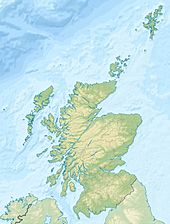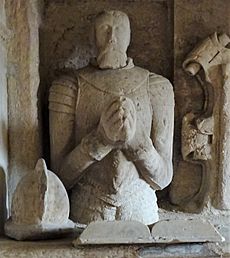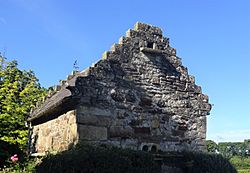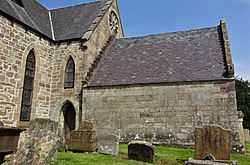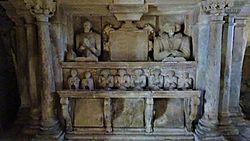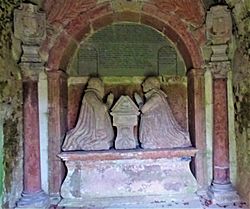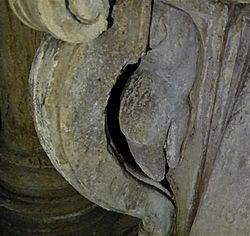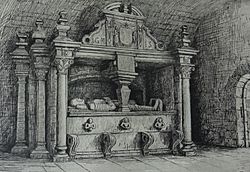Glencairn Aisle facts for kids
Quick facts for kids Glencairn Aisle |
|
|---|---|
| Riccarton, Ayrshire, Scotland grid reference NS414407 |
|
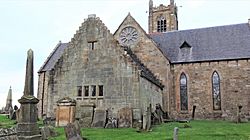
The Glencairn Aisle and St Maurs-Glencairn Church
|
|
| Coordinates | 55°38′04″N 4°31′12″W / 55.634464°N 4.5200130°W |
| Type | A Burial Aisle and crypt |
| Site information | |
| Owner | Clan Cunningham |
| Open to the public |
By arrangement |
| Condition | Maintained |
| Site history | |
| Built | 16th century |
| Built by | James Cunningham, 7th Earl of Glencairn |
| In use | 16th to 20th centuries |
| Materials | Ashlar masonry |
The Glencairn Aisle or Glencairn Vault is a special chapel in Kilmaurs, East Ayrshire, Scotland. It's a very old building, built in the 1500s, that served as a private place for prayer and quiet thinking. It also holds a large memorial and is the burial place for the Cunningham Earls of Glencairn and their family. An 'Aisle' is usually a part of a church that might have a burial area underneath, a family seating area above, and sometimes a private room, like the one at Glencairn Aisle.
This aisle is home to an amazing stone monument from 1600. It's beautifully carved and remembers James Cunningham, the 7th Earl of Glencairn, his wife Margaret Campbell, and eight of their children. This monument is the oldest of its kind in Ayrshire from the 1600s and one of the oldest built in Scotland after the Reformation. Other similar monuments in Ayrshire include the Kennedy Aisle at Ballantrae (around 1601) and the Skelmorlie Aisle at Largs (1639).
The Glencairn Aisle is connected to the St Maurs-Glencairn parish church. This church was given to Kelso Abbey way back in 1170. In 1600, James, the seventh Earl of Glencairn, added the Glencairn Aisle to the church. Inside the aisle, you can see the 17th-century monument he ordered for himself, his wife, and their family. You can also find memorial plaques for other Cunningham family members from places like Caprington, Corsehill, and Robertland.
Contents
Who Were the Cunninghams, Earls of Glencairn?
Kilmaurs has always had strong ties to the Cunningham family. They were given land by the King in 1319 after supporting him at the Battle of Bannockburn in 1314. The Cunningham leaders didn't live in Kilmaurs as much after 1484. This was when Sir William Cunningham of Kilmaurs married Margaret Denniston, and her family brought them new lands, including Finlaystone, which became their main home.
In 1786, James, the fourteenth Earl of Glencairn, sold the Kilmaurs estate. This ended the Cunningham family's long connection with the area.
What Was the Collegiate Church?
In 1413, Sir William Cunninghame set up Kilmaurs church as a 'collegiate church'. This meant it was a special church with its own group of priests and staff, not controlled by a monastery. Its main purpose was to hold many prayers for the founder's family, both past and future. Maybole was the only other collegiate church in Ayrshire.
Each priest in the college received money or land from the founder. They followed special rules about how to conduct services and live their lives.
In the mid-1500s, after the Reformation in Scotland, people stopped believing in purgatory. So, the practice of praying for souls stuck there was no longer allowed. The Cunningham family had to stop using their buildings for these old practices. The 5th Earl took control of the college and its lands. Kilmaurs Collegiate Church continued as the local parish church, but its other buildings were used for different things. For example, one building, which might have been a grain store, became a dovecot (a home for pigeons).
An old painting from the 1920s shows a building called the 'Tour' in good condition. It was knocked down in the 1960s. This building might have been where the monks from Kelso Abbey managed things and lived. Much of its stone was later used to build a garden wall.
The Earls used their influence over the collegiate church to help their family and friends. They also leased land and collected tithes (a portion of crops or income).
The Glencairn Aisle's History
The Glencairn Aisle has changed a lot since it was built. It was originally thought to be the main part of the old church where the altar was. Old records suggest it might have been the Cunningham family's private chapel. Recent digging in 2024 found older stone foundations, which could be from an even earlier chapel.
After the Reformation, churches changed. The focus moved from the altar to preaching. So, the eastern part of churches, where the altar was, became less important. Instead, pulpits were set up on a side wall with a communion table in front.
In 1633, local landowners agreed to pay the minister and maintain the church. Many old church parts were turned into family burial places. Even though burials inside churches became restricted, these old parts were seen as separate, so families started burying their dead in crypts underneath them.
The Glencairn Aisle was once connected to the church, with only a railing or screen between them. It was like a side wing of the church. Over time, the aisle's roof and northern wall became unsafe. In 1838, the church had to knock down the northern wall, making the aisle shorter by about 1.8 meters (six feet). A new wall was built. This suggests the church might have been built next to an older aisle or chapel, rather than the other way around.
Later, a door was added between the aisle and the church for the minister. This door was removed in 1913 when the buildings were joined again. This is when some old carved stones were found being used as door frames and were moved into the aisle for safekeeping.
In 1888, a wall inside the church was moved, creating an archway where the Glencairn Aisle originally opened into the church. The main monument, which was once in the center of the old church's east wall, no longer looks central because of these changes.
There used to be a gap between the aisle and the church, shown on old maps. In 1888, the church had big changes, including adding a tower. In 1913, an organ was installed. To make space for its bellows, the church was extended to include the aisle, and a new wooden door was added.
An upper room, perhaps a 'Retiring Room', might have existed in the aisle, suggested by a window in the south wall. But when the roof collapsed and was replaced with a curved stone roof, this room became much smaller, and the window was blocked up, except for a small vent.
You can see the Cunningham family's 'Y' symbol on the outside walls. A sundial on the corner of the aisle is dated 1753. The building is about 7.5 meters (25 feet) long and 7.0 meters (23 feet) wide, made of grey stone.
The windows have parts that are just for looks, not for light. This style was popular in England and Denmark, showing outside influences.
The church once housed the local school, and the aisle and its monument were damaged by students. Local shoemakers also took good quality stone from the aisle to use as whetstones.
In 1963, the Glencairn and St Maurs churches joined together. Plans were made to connect the aisle to the church for the choir or as a meeting room, but these plans never happened.
The Burial Crypt Beneath the Aisle
The crypt is where the Cunningham family's coffins were placed. It's under the aisle and was once accessed by a stone slab with metal rings. This access is now covered by the floor. The crypt is about 2.4 by 2.4 meters (8 by 8 feet) and 1.2 meters (4 feet) deep, carved roughly from the rock. Coffins were slid down a slope into it. Since the coffins weren't covered in lead, the wood has mostly rotted away.
Alexander Cunningham, the 5th Earl of Glencairn, was buried here. It's believed that the 6th Earl and his ancestors were also buried in this crypt. The last known burial was around 1788, for a Mr. Hamilton.
There's a story that a polished red skull found in the crypt belonged to William, the 9th Earl of Glencairn. His wife, Lady Margaret, supposedly kept it out of love and it was buried with her. The rest of his body was buried in Edinburgh.
In 1842, some railway workers broke into the crypt, leaving it open. This caused rubbish, soil, and stones to fall inside. The wooden coffins rotted, and the bones became scattered.
In 1870, the local schoolmaster, Duncan McNaught, and his helpers dug out the crypt. They removed three cartloads of dirt and found the skulls of fifteen people. All the bones were put into a new chest, and details of the work were sealed in a container for future generations.
Memorial Plaques in the Aisle
- A brass plaque on the north wall remembers James Cunningham, 14th Earl of Glencairn, who was a friend of Robert Burns. He is buried in Falmouth, England.
- Another brass plaque on the west wall remembers Fairlie Cuninghame (1883–1971).
- A carved white stone plaque on the west wall remembers Captain Alfred Keith Smith Cuninghame, who died in 1917.
- Sir Thomas Montgomery Cuninghame of Corsehill is remembered by a brass plaque on the west wall. His wife, Dame Charlotte Montgomery Cuninghame, is also on the plaque.
John Conyngham, son of the 7th Earl, was buried in the crypt in 1628, but there's no plaque for him.
The 7th Earl's Family Monument
James Cunningham first married Margaret Campbell. They had two sons and six daughters. After Margaret died in 1610, he married Agnes Hay, but they had no children.
The Earl died in 1630. The monument shows him and his wife from the waist up. He wears armor, and she has a tartan plaid. Their eight children are also shown as sculptures. The two sons are dressed in male clothing, and the six daughters in female clothing. Their heights in the sculptures seem to show their ages. The sons have their initials carved below them.
Figures on monuments that are praying or mourning are called 'Weepers'. These were usually children or close relatives.
The children's statues might have once been painted in bright colors, like the 1641 Hamilton Mausoleum which was so colorful it was called the 'Picture House'. The Bargany Aisle monument at Ballantrae was also brightly painted.
The monument was designed to show the Earl, Countess, and their children worshipping in their private seating area in the church.
The coat of arms at the top of the monument has the Cunningham 'Y' symbol on the left and Campbell symbols on the right. It also has the initials 'MC' for Margaret Campbell and 'IC' for James Cunningham. Two rabbits (coneys) support the shield, and there are carvings of birds, possibly peregrine falcons, showing a popular sport of the time.
Some small empty squares on the monument might have once held metal decorations or initials. An intertwined monogram with 'I, M & C' (for James and Margaret Cunningham) is visible. A panel below the daughters once listed their names and marriage details, but it's hard to read now. The date "1600" is clear, as is the message: "Nothing surer than death, be therefore sober and watch in prayer."
Two of the supports for the bible rest in front of the children are snakes biting their tails. This symbol, called an ouroboros, represents rebirth and renewal.
Because of Presbyterian beliefs, the monument does not have crucifixes or images of the Virgin Mary. Latin, which was linked to Catholicism, is hardly used.
The monument has survived well because it was built from local stone.
The Funerary Helmet
A stone carved helmet, called a 'Mortuary Helm', lies on the Earl's bible board on the monument. These helmets were often placed near the statues of important knights or nobles from the 1300s to the 1600s, especially if they were known as warriors. These helmets were often painted.
The Family Coat of Arms
The coat of arms on the monument shows the symbols of both the Cunningham and Campbell families joined together. The Cunningham side (left) has a black sheaf-fork on a silver background. The Campbell side (right) has gold and black patterns, a blue and silver checkered stripe, and an old ship (a galley) with red sails and black oars.
Above the shield is a helmet with a unicorn on top, which is the Earl's crest. On a scroll below the shield, it says 'Fork Ovir' (Fork Over), which is the Cunningham family motto. Two animals support the shield: a rabbit on the left and a stag (male deer) on the right. This coat of arms was once brightly painted and gilded.
It's unusual that the letters ‘D M C’ (for Dame Margaret Campbell) and ‘E I C’ (for Earl James Cunningham) are on the shield, as this isn't normal for coats of arms. The letter 'I' is used instead of 'J' because the Latin alphabet didn't have 'J'.
The ship carved on the Campbell side doesn't quite match the official description of their coat of arms. It looks more like a galleon with three masts, not a galley with oars.
The Master Mason
The mason who carved this monument was David Scougal from Crail in Fife. He is thought to have carved his special 'mason's mark' and his name on the right side of the monument. The carving says "Wroch Be David Scwgal masson bvrges in Carel." This means "Worked by David Scougal, master mason in Crail."
The stone used for the monument might be local, or it could have been brought by the mason. The design of the monument mixes old medieval styles with newer Renaissance ideas.
In the 16th and 17th centuries, masons started signing their work. The Glencairn Monument might be an example of this change, where both a mark and an inscription identify the mason.
Dame Mariot or Margaret Cunningham, Countess of Glencairn
Margaret was also called Mariot, which is a Scottish Gaelic version of Margaret. Her father, Sir Colin Campbell, was a Protestant. However, church records show that Margaret might have been a Roman Catholic. She often didn't go to the Presbyterian church services in Kilmacolm and was even called 'contumax' (meaning she refused to appear in court). Instead, she seemed to have private church services at her home. Despite warnings, she never attended the Presbyterian church, though her husband, James, did.
Children of James and Margaret Cunningham
- William Cunningham, 8th Earl of Glencairn: Married Lady Janet Ker. Died 1631.
- James Cunningham of Stevenstoun & Kerilaw: Died after August 1612.
- John Cunningham of Cambuskeith: Died March 1628.
- Lady Ann/Agnes: Married James Hamilton, 2nd Marquess of Hamilton in 1603. Died 1625.
- Lady Susanna/Susan: Married Alexander Lauder in 1610. Died 1623.
- Lady Margaret: Married Sir James Hamilton in 1598, then Sir James Maxwell in 1603. Died after 1622.
- Lady Catherine: Married Sir John Cunningham of Glengarnock in 1612.
- Lady Jean: Died 1597. Was supposed to marry the Earl of Cassillis, but he married someone else.
- Lady Mary/Marie: Married John Crawford of Kilbirnie.
Repair and Restoration of the Aisle
In 1793, the aisle was in a "shameful state of disrepair," but efforts to raise money for repairs failed. A few years later, some small changes were made, like adding a gate to stop people from entering, after a visit from Lady Don. The roof later collapsed, damaging parts of the monument.
In 1846, the roof was replaced with a new vaulted ceiling. The upper window was blocked up, and new windows were added to let in light. However, no work was done on the monument itself at this time.
In 1870, Duncan McNaught, a local schoolmaster and historian, was asked to help restore the monument. The crypt was dug out, and parts of the monument were found and used to help with the restoration. A mason named Robert Boyd extensively restored the monument. This work was done to honor Sir Thomas Montgomery Cuninghame, who died in 1870.
A memorial to Captain Alfred Smith Cuninghame on the west wall says that the aisle was restored in his memory in 1917 by his father.
In 1989, the Glencairn Aisle Trust raised £3000 for cleaning the outside stone and re-roofing the vault.
More recently, in 2022, the Glencairn Aisle Preservation Committee and Clan Cunningham International raised £6,000 for repairs to the monument. They removed old cement repairs from the Countess's head and replaced rusting iron supports.
The Bargany or Kennedy Aisle at Ballantrae (1601) seems to have used the Glencairn Aisle monument as a model. Studying it might give clues about how the Glencairn Aisle monument originally looked.
Cross Slabs and Carved Stones
Inside the aisle, there are two medieval carved stone slabs. One has a dragon and vine leaves. Both have a carving of shears, which represents Atropos, a Greek goddess who was believed to cut the thread of life. These thick, carved slabs might have been the lids of stone coffins. The founders of the Kilmaurs Collegiate Church in the 1400s, Sir William and Lady Margaret Cunningham, would have had fancy grave covers like these.
Also in the aisle are two carved stone pillars, parts of the monument's decorations, and a piece of a window with the Cunningham 'Y' carving. In 1888, during restoration, carved doorposts and a stone basin were found in the north wall of the aisle. These stones were elaborately carved and had their carved faces turned inwards.
Some carved stone pieces look like they came from older medieval tombs. Alexander, the 5th Earl of Glencairn, was given the job of destroying all 'idolatry' monuments in West Scotland. This might have included any older Cunningham family monuments in the Glencairn Aisle at that time.
Historical Timeline of the Glencairn Aisle
- 1170: The church was given to the monks of Kelso Abbey.
- 1413: Sir William Cunningham set up a collegiate church at Kilmaurs.
- 1484: The Cunningham Earls of Glencairn officially moved their main family home to Finlaystone House.
- 1560s: The Scottish Parliament made the Catholic Mass illegal. Collegiate churches stopped existing.
- 1574: Alexander Cunningham, 5th Earl of Glencairn, was buried in the Glencairn Aisle crypt.
- 1597: Lady Jean Cunningham died and might have been buried in the crypt.
- 1600: James Cunningham, 7th Earl, ordered the memorial monument for the church.
- 1610: Margaret Cunningham, Countess of Glencairn, died.
- 1630: James Cunningham, 7th Earl of Glencairn, died and was buried in the Glencairn Aisle with his first wife.
- 1753: William Coats, the minister, added a sundial to the aisle.
- 1786: James, 14th Earl, sold the Kilmaurs estate, ending the Cunningham family's long connection with the area.
- 1788: Mr Hamilton of Bardowie was the last known burial in the crypt.
- 1793: The aisle was in "shameful state of disrepair," but fundraising for repairs failed.
- 1838: The aisle's northern wall was demolished because it was unsafe, making the aisle shorter.
- 1840 (around): The roof collapsed, damaging parts of the monument.
- 1842: Railway workers broke into the crypt, leaving it open to the elements.
- 1846: The roof was replaced with a vaulted ceiling.
- 1870: Dr Duncan McNaught, the local schoolmaster, helped restore the monument. The crypt was excavated, and bones were collected.
- 1913: The aisle was joined to the church again when an organ was installed.
- 1917: Colonel Cuninghame of Caprington "restored the aisle" in memory of his son.
- 1960s: The 'Tour' building of the collegiate college was demolished.
- 1989: The Glencairn Aisle Trust raised money for external cleaning and re-roofing.
- 2019: The stained glass windows were replaced.
- 2021: The Glencairn Aisle Preservation Committee was formed to raise funds for restoration.
- 2022: The Glencairn Aisle Preservation Committee and Clan Cunningham International raised £6,000 for monument repairs.
- 2023: The Cunningham Clan Chief visited the aisle.
|


